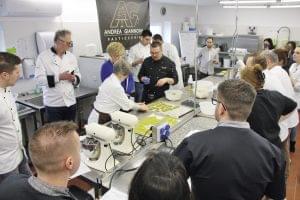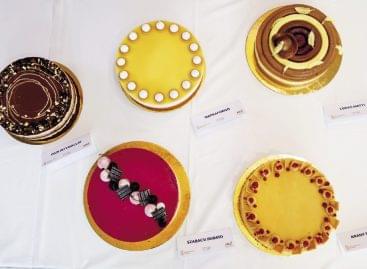Magazine: Flavours of Sicily
In February the Guild of Hungarian Confectioners held a master course in the educational workshop of the guild. Andrea Giannone from Scicli in Sicily was the invited confectioner, who introduced the characteristic products of the region, e.g. brioche, almond biscuits, Modica chocolate, Turk’s head dessert, etc.).

He told the story of every dessert, for instance it was the Spanish conquest that brought Modica chocolate to Sicily – not only the cocoa beans, but the Mexican preparation method as well. The beans are simply ground, mixed with cane sugar and spiced. Modica chocolate has really strong, characteristic taste and its texture is very different from other that of chocolates.

Sicily is also the home of the tastiest sweets filled with ricotta cream, such as cannolo – an emblematic Italian dessert that is popular all over the world. Mr Giannone brought some of the old bamboo poles that were used for frying at very high temperature; what is more, the poles could even be reused! Simple macaron dough varieties and biscuits were also introduced. The course was two days long and members of the sweeTEN group also participated in the training.

//
Related news
Drought and lack of water also cause serious problems in tourism
🎧 Hallgasd a cikket: Lejátszás Szünet Folytatás Leállítás Nyelv: Auto…
Read more >Sirha Budapest 2022 – The biggest food and HoReCa event in Central and Eastern Europe
🎧 Hallgasd a cikket: Lejátszás Szünet Folytatás Leállítás Nyelv: Auto…
Read more >Magazine: Sunflower becomes Cake of Hungary in 2021
🎧 Hallgasd a cikket: Lejátszás Szünet Folytatás Leállítás Nyelv: Auto…
Read more >Related news
Experience, timing, awareness: a new travel logic is emerging towards 2026
🎧 Hallgasd a cikket: Lejátszás Szünet Folytatás Leállítás Nyelv: Auto…
Read more >The Temu model is at a turning point: extra-cheap online imports may become more expensive from 2026
🎧 Hallgasd a cikket: Lejátszás Szünet Folytatás Leállítás Nyelv: Auto…
Read more >Even though the price of cocoa has halved, chocolate will not become cheaper
🎧 Hallgasd a cikket: Lejátszás Szünet Folytatás Leállítás Nyelv: Auto…
Read more >






